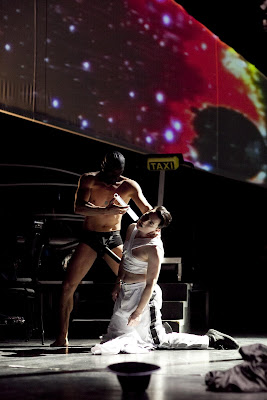NOTE: I took another look at this review in October 2014, now that a film of Bruce LaBruce's Pierrot production is coming to New York; on Twitter, the great composer Alex Temple drew my attention to the the potentially anti-trans politics of LaBruce's staging (based on the publicity materials). And then I read this review again and realized the generally disgusting naiveté with which I wrote about trans issues. I certainly had 0 awareness of how problematic this staging might be, and further how insensitive my discussion of it is. I'm not going to re-evaluate the production since I honestly don't remember much more than I what I wrote here, but I just want to point out that what I've written comes from a fairly idiotic place: basically a knowledge of Pierrot Lunaire and not much else in the world. 2014 me would write a very different review, or not review it at all. So read below with caution, with the knowledge that it reflects a crude understanding of a lot of things. Sorry. (I should probably do this with plenty of my old Seated O writing, but this seems like a pretty egregious example.)
Pierrot Lunaire is quintessential Expressionism, turning outward a manic inner life, externalizing artistic madness: the commedia dell’arte clown Pierrot stumbles through a haze of psychosis, in twenty-one nightmarish aphorisms. So it might seem like a contradiction of Arnold Schoenberg’s premise to stage the work—though it has its origins in recitation and cabaret, it is still a purely musical piece.
But Pierrot is also a landmark for another reason. Though Schoenberg had eroded tonality five years earlier in his Second String Quartet, the 1912 Pierrot is the archetypal work-to-hate, the one which most immediately alienates a classical audience who isn’t interested in “ugly music.” And in this way, Bruce LaBruce’s staging of Pierrot at Hau Eins does it justice: the unsettling music becomes just one part of an evening of unsettlement. After all, when the soprano is pretending to fellate the conductor, who cares if she’s not singing in C major?
LaBruce, best known as a director of independent films and gay pornography, takes the music as a departure point, staging his work in and around it: we begin with an excruciatingly-long, graphic make-out between Pierrot and his Colombine, him dressed as a young gangsta*, her as a trashy post-Gaga teen. Finally, the music begins, and Colombine dances lewdly for her lover, who intones the ghastly Mondestrunken.
Schoenberg divides his melodrama into three parts, which LaBruce retains as three acts. The crux of the play lies in that Pierrot is actually a she, not a he. Early on, Colombine’s “capitalist pig” father discovers Pierrot’s true identity, exposing her to Colombine, and Pierrot swears to get her back. The rest of the work stages Pierrot’s crude attempts to win back Colombine and her father’s approval: the search for a penis. After an unsuccessful attempt to castrate an S&M dancer, who reveals himself to be a castrato, together the unlikely pair lures a cab driver into their scheme, violently mutilating him and stealing his manhood. In the final moments, Pierrot eerily presents herself to Colombine and the father, clad in a long robe under which the dancer also stands, as a freakish “man.”
In creating this unlikely scenario, LaBruce effectively combines high drama and kitsch. Each of Pierrot’s gestures feels deliberate, an outcry of her fierce desire for manhood and Colombine. Her violence matches that of the music—she takes a knife to her breasts while moaning the words of Rote Messe (“He shows the anxious souls/The dripping red host”). But there are also moments of slapstick comedy, as when Pierrot runs furiously on a treadmill while breathlessly singing the gallows song (“The withered whore/With string neck/Will be his last beloved”), and campy supertitles fill in dirty little jokes—when the father rips off Pierrot’s clothing to reveal her true gender, they flash “Wikileaked!”
The hyper-sexualized violence doesn’t feel far from the original work’s Expressionist context (Pierrot dancing around with a bloody penis is really just a twenty-first century update of the axe dance in Strauss’s Elektra). Certain aspects feel a bit over the top—vigorous masturbation, disgusting slurping noises—but the overall effect is of refreshing bluntness.
Much of the evening’s success can be attributed to the magnetic actress Susanne Sachsse, who hoarsely voiced her way through Schoenberg’s tricky Sprechstimme, creating a compelling character if occasionally missing a note or two (she could make a terrific Lulu if LaBruce ever chose to direct the Franz Wedekind plays). Premil Petrović conducted an oddly timid performance, with the quintet of musicians sounding hesitant though precise in the snarling atonal score. Video projections by Marius Roth added atmosphere, often referencing Albert Giraud’s poetic texts more explicitly than LaBruce’s staging.
Sometimes I was left with the feeling that LaBruce took the music for granted. The work occasionally felt like a silent, decadent film with Schoenberg as accompaniment (the old-timey supertitle font added to the effect), and the theatrics never fully addressed the crystalline classical forms of the composer’s individual songs. LaBruce has created bloody, visceral theater in-the-moment; it’s too bad that in doing so, he sucked out some of the blood of Schoenberg’s music.
*That’s the first and last time I will ever use that word on this blog, I swear.


Well written and amusing, thank you!
ReplyDelete